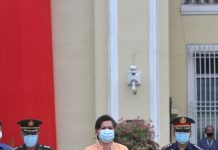Part I
[EDITOR’S NOTE: This is part of a series of three articles on population written by award-winning columnist Rene B. Bartolo. The articles, first published in Bartolo’s Richochet column in The Mindanao Times, the city’s oldest newspaper, won first prize in the POPDev Media Awards bestowed by the Philippine Legislators’ Committee on Population and Development, for three consecutive years, installing the columnist in the hall of fame.]
“Truth comes neither in parcels nor partitions; truth is integral, total.” St. Thomas More, Dialogue of Comfort against Tribulation, 1535
House Bill (HB) 5043 or the “Reproductive Health, Responsible Parenthood and Population Development Act of 2008” has been under plenary deliberation in the House of Representatives since September 2008.
The House committee on rules approved the RH bill for plenary consideration, the first time such a bill reached plenary. Three committees — appropriations, health, and population and family relations — had approved the bill the month before.
“Reproductive health” is the recurring theme of all the other legislative proposals that deal with family planning or responsible parenthood. Supporters define reproductive health as “the state of complete physical, mental and social well-being and not merely the absence of disease or infirmity, in all matters relating to the reproductive system and to its functions and processes.”
This definition implies that “people should be able to have satisfying and safe sex lives and that women and men should have equal say on matters related to sexual relations and reproduction.”
For near a year now, the proposed law has been deliberated in Congress for eventual passage or rejection. For near a year, members have viewed and deliberated on the legislative proposal not in its totality, but from fragmented perspectives and largely prejudiced points-of-view.
And the RH Bill hangs hostage in the halls of the House.
The main opponent of the RH Bill is the powerful and influential Catholic Bishops Conference of the Philippines and allies in the House of Representatives.
The CBCP accuses the proponents and supporters of the bill as people who would establish in the country “a new moral order” that would push a national population control program and promote abortion and birth control.
These are programs that are anathema to the thinking of the church. The bishops believe that the real goals of the “reproductive health” legislation are the same as the goals of any population control program: to limit family size and obtain funds for that purpose.
The church asks: “Would population control address poverty?” It does not believe so.
The church maintains that “population growth does not necessarily lead to income and resource decline,” but it closes its eyes to the real burden that a burgeoning population imposes on the country’s limited resources and unstable economy.
The National Statistics Office (NSO) places the Philippine population at 88.575 million Filipinos as of August 1, 2007, with a population growth rate of 2.1 percent, one of the highest in the world. Of the 15 most populous countries of the world, the Philippines ranks 12, despite our relatively small size.
Every minute, four babies are added to the population. If the population growth rate continues, there will be 170 million Filipinos in 2030.
The country can hardly support 88 million Filipinos; a population of 170 million will be simply disastrous.
The First Quarter 2009 Social Weather Survey, fielded over February 20-23, 2009 found that 34.2%, or roughly one in every three adult Filipinos – an estimated 14 million — was jobless. Another survey for the same quarter showed that 16.9% of the population, especially among families whose heads had recently lost their jobs, was suffering from extreme hunger.
As more jobs are lost, the hunger spreads while the population inexorably grows – these are facts that the CBCP does not append to the “truth” it presents about HB 5043.
HB 5043 proposes to provide “education and information on human sexuality and responsible parenthood in schools…” Reproductive Health Education will be taught to students from Grade 5 up to Fourth Year High School, including non-formal education.
The church opposes classroom-based sex education, saying “it will focus on information about sex rather than value formation.” The Church calls sex education a “dose of hedonism for the Filipino children.”
The church maintains: “Such education damages the children’s natural stages of development and will not make them wholesome persons but hedonistic, promiscuous, and selfish youth who will become irresponsible adults.”
The church fails to accept that children receive daily a liberal dose of hedonism from the tri-media, entertainment outlets, the tools of information and communication technology, and from a largely permissive society; yet they are not provided with the information to avoid experimental and promiscuous sex or the protection against resultant unwanted pregnancies.
The CBCP accuses the RH Bill of being anti-poor. But the following are things the bishops do not mention.
In the Philippines today, the poor experience the worst implications of poor reproductive health care. The mortality rates of the newborn, infant, and children under-five are significantly higher among the poor than among the well-to-do.
Only 25 percent of poor women give birth with assistance of health professionals while 92 percent of women belonging to the upper class have professionals attending to them.
The RH bill recognizes that it remains to be the State’s responsibility to ensure the well-being and health of its people, poor and rich alike. The bill realizes that unless the health of the poorest improves, the population will become increasingly poor and unhealthy. [To be continued]
0 Comments
Oldest






